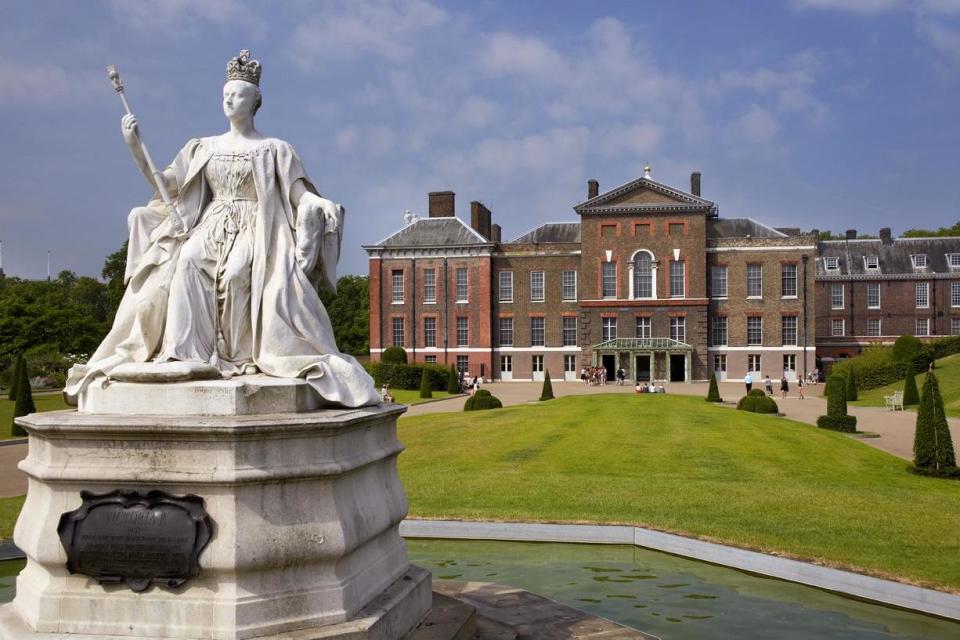The history of Kensington Palace: Five excellent things you never knew about it

Harry and Megs are expecting their first baby. Huzzah! Which is why we thought we'd delve a little closer into the history of their former home, Kensington Palace.
More than 300 years of royal and political history stalk the walls of the famous regal residence. To this day, it's still the official royal residence of the Duke and Duchess of Cambridge, Prince George, Princess Charlotte, Prince Harry, the Duke and Duchess of Gloucester, the Duke and Duchess of Kent, and Prince and Princess Michael of Kent.
Originally built as a two-storey Jacobean mansion, it fell into the hands of the crown during the reign of King William III and Queen Mary II. After months of planning, it was eventually transformed into a regal palace by world-famous architect Sir Christopher Wren under the guidance of William, Mary and Queen Anne. Now, more than half the palace is divided into royal apartments, and are all inhabited by various members of the royal family and paid for by Her Majesty the Queen. Everything else is luckily open to us common folk.
As Kensington is so obviously fascinating, we thought we'd uncover five lesser-known facts about the place. From haunted rooms to the gates that helped a nation grieve, here's a nice spot of regal Friday night reading for you.
It's said to be one of the most depressing places for women in London
Female royals have had it hard at Kensington Palace. Queen Anne fell pregnant 17 times with her husband Prince George of Denmark while living at the palace. Sadly, she died without any surviving royal children whatsoever, and as a result, fell into multiple depressive episodes throughout her reign at the royal digs.
On the opposite side of the spectrum, Queen Caroline died after her eighth pregnancy when an umbilical hernia resulted in a botched surgery. More recently, it's been reported that numerous friends, aides and servants of the late Princess Margaret and Princess Diana have said that both were unhappy whilst living at the royal residence.
Men haven't had it so good either. Back in the 18th century, the UK was under the reign of King George III. Popularised for being quite bonkers, it's well known the king did not get on very well with his son, Prince Frederick, so much so that the monarch had him banned from Kensington at one point. Sad and angry, Frederick decided to vent his frustrations during a game of cricket one day. After being hit in the chest with a ball, he unexpectedly died. The news was delivered to King George during a game of cards. His response to his son's death? A simple "Good."
A post shared by Englands Royal Family (@englandsroyalfamily) on Sep 5, 2017 at 5:54pm PDT
The nursery is haunted
Have you ever heard of Peter the Wild Boy? During the days of King George II, a man named Peter, who the king found wandering aimlessly in a forest in Hanover, used to the walk the long narrow hallways of the palace. It's thought that innocent little Peter had suffered from a genetic condition known as Pitt Hopkins. If you've never heard of it, the rare disease is characterised by developmental delay, heavy breathing, apnea and severe facial abnormalities. Peter died on February 22, and according to palace curators, still haunts the King's staircase to this day, along with King George II and Princess Sophia.
Apartment 1A however, home to the Duke and Duchess of Cambridge, Prince George and Princess Charlotte is said to be the most haunted placed in the royal complex. If you don't believe us, take King George's word for it: before going six feet under, he was reportedly spotted in the King's Gallery moaning, 'Why won't they come!?'. They, allegedly, were his last words.
A post shared by Earle Arney (@earle_arney) on Nov 26, 2017 at 2:20pm PST
A reigning monarch hasn't lived there in 250 years
The last sovereign who called Kensington Palace home was King George II, who died at the Palace in 1760. After years of neglect, the place fell into a sorry state of disrepair and by 1890, was threatened by lords and ladies riding bulldozers. Luckily, Queen Victoria (who was born at Kensington) saved the place for the nation after she persuaded Parliament to approve a two-year restoration.
It's only a palace by chance
Originally, the mammoth palace was a mansion called Nottingham House built for wealthy businessman Sir George Coppin during the Jacobean Era (1567-1625). When King William ascended the throne with Mary as Queen consort in 1689, they were on the hunt for a new place to live. Why? Well, King William suffered with extremely bad asthma. Because Whitehall Palace was so close to the river – an even filthier place back then – the Queen decided it was about time they central London for something a little further out of the metropolis. Surrounded by green, green grass and the odd cow, the royal couple became besotted with Kensington after the fresh air did wonders for the King's breathing. As a result, they purchased Nottingham House in the summer months of 1689 for a sum of roughly £20,000.
More than one million bouquets were left at the palace gates after the tragic death of Princess Diana.
They stretched nearly five feet deep. Following her death, the Princess' private apartment lay empty for years. No one has ever lived there since.
Want more interesting facts? Here's seven things you didn't know about the Tower of London!

 Yahoo News
Yahoo News 